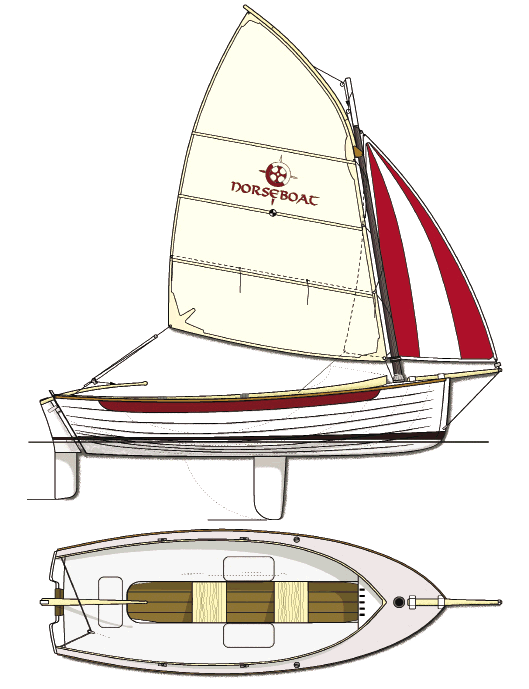NorseBoat 12.5
I'm not sure rowing and sailing and cruising and camping is everyone's cup of tea, but if it did appeal to you, the Pacific Northwest would be the perfect place to do it. I love to row. I hate to camp. The NorseBoat people had success with the Chuck Paine-designed 17.5 and now they are introducing a 12.5-foot version designed by Laurie McGowan. The 12.5 is small enough to be very easily towed behind a modest-sized car and could be trailered anywhere to start a cruise so that you did not have to deal with open water. I can see this boat being cruised around the San Juan Islands, but sailing it across the Straits of Juan de Fuca, while possible, could be a bit of a challenge for anyone.

The design targets that ensure good sailing and rowing performance are fairly similar. To make a rowing boat track well you want a long, straight keel. To make a boat efficient to power with oars you want a moderately low prismatic coefficient. The long keel will help the rowers but will make the 12.5 slow to tack, but this is not a high-performance dinghy anyway. To keep the bow dry the 12.5 has considerable flair to the bow sections. I suppose for pure sailing performance you may want a finer bow for speed to weather, but with this simple, boomless gaff rig this boat is not designed to be an upwind rocket. The listed displacement is 323 pounds and I would consider this heavy for a 12.5-foot rowing boat but I can't tell from the data I have what is included in that displacement.
One of the nice things about this design is that the entire sailing rig fits into a padded bag that stows in the cockpit when you want to row. If you are halfway across the bay under oar power and the breeze comes up you can rig this boat easily and be under sail in minutes. There is 51 square feet in the gaff-headed mainsail and 18 square feet in the optional jib. The jib is on a wire luff furler. I really like the curved gaff. This detail can be seen on the Scandinavian Skerry cruisers of the 1920s. There is no boom with this rig. For me, that's a bit of a problem. Booms work. They hold the sail out. Maybe on this rig the curved gaff will work like a boom, just on the other end of the sail. I did a similar rig on a dinghy for a client and I just got an e-mail from him today saying he wants to put a boom on the rig. As drawn, the 12.5 sheets to the corner of the transom, so this sheeting point has to accommodate all apparent wind angles. I'm sure it works. I am not sure it would work for me. The short mast is carbon fiber.
The NorseBoat 12.5 is built at a new plant in Lunenburg, Nova Scotia. You can buy a complete "hybrid" model-wood deck with GRP hull-or you can buy the hybrid model in kit form. The company even offers an all-wood model in complete and kit versions, but it is an additional $2,000.
My pal Pogen has a 17.5-foot NorseBoat and he loves it.
LOD 12'6"; LWL 11'4"; Beam 4'5"; Draft 6" (board up), 2'5" (board down); Displacement 323 lbs.; Sail area 69 sq. ft.; SA/D 23.45; D/L 99; L/B 2.83
NorseBoat Limited, RR1 Belfast, PE, Canada C0A 1A0, (902) 659-2790, www.norseboat.com. OBE: $9,495 Our Best Estimate of the sailaway price.

Comments